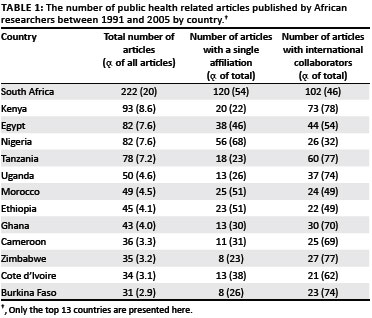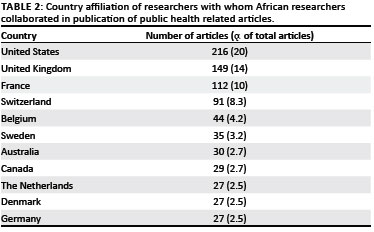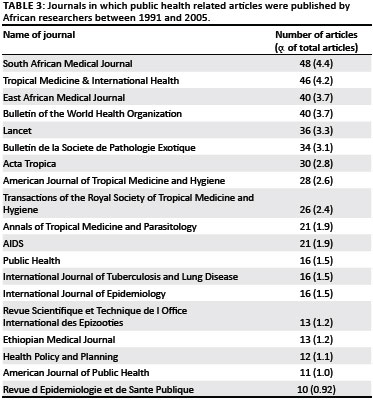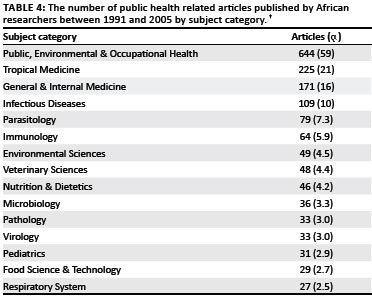Servicios Personalizados
Articulo
Indicadores
Links relacionados
-
 Citado por Google
Citado por Google -
 Similares en Google
Similares en Google
Compartir
South African Journal of Science
versión On-line ISSN 1996-7489
versión impresa ISSN 0038-2353
S. Afr. j. sci. vol.107 no.5-6 Pretoria may./jun. 2011
http://dx.doi.org/10.4102/sajs.v107i5/6.309
RESEARCH ARTICLE
Bibliometric analysis of public health research in Africa: the overall trend and regional comparisons
Kun-Yang ChuangI; Ying-Chih ChuangI; Meng HoI; Yuh-Shan HoII,III
ISchool of Public Health, Taipei Medical University, Taipei City, Taiwan
IITrend Research Centre, Asia University, Taichung, Taiwan
IIIDepartment of Public Health, China Medical University, Taichung, Taiwan
ABSTRACT
Many diseases in Africa can be prevented with appropriate public health interventions. This study aimed to assess the bibliometric characteristics of public health related research articles published by researchers in African institutions from 1991 to 2005. Data used in this study were obtained from the online version of the ISI Web of Science: Science Citation Index Expanded (SCI-Expanded). Articles published between 1991 and 2005 that had the phrase 'public health' in the title, author keywords or abstract, and had at least one author whose contact address was in an African country, were selected for analysis. The annual number of public health related articles published by African researchers significantly increased from 28 articles in 1991 to 135 articles in 2005, a 382% increase. International collaboration also increased: from 45% of articles having international collaborators during 1991-1995, to 52% during1996-2000, and to 67% during 2001-2005. Collaborations were mostly with European and North American countries. Keywords, subject categories and collaboration patterns of articles varied across regions, reflecting differences in needs and collaboration networks. Public health related research output, as well as international collaborations, have been increasing in Africa. Regional variation observed in this study may assist policymakers to facilitate the advancement of public health research in different regions of Africa, and could be useful for international organisations in identifying needs and to allocate research funding. Future bibliometric analyses of articles published by African researchers, can consider conducting regional comparisons using standardised methods, as well as describing the overall patterns, in order to provide a more comprehensive view of their bibliometric characteristics.
Introduction
In 2005, Africa had about 12% of the world's population with more than 840 million people.1 Africa also bears 24% of the disease burden but has only 3% of health workers and commands less than 1% of the world's health expenditures.2 In 2000, the World Health Organization (WHO) indicated that the six leading causes of death in Africa were HIV/AIDS, malaria, lower-respiratory infection, diarrheal diseases, perinatal conditions and measles.3 Many of these deaths could be prevented by appropriate public health interventions.
Despite the many pressing public health problems, no research has evaluated the bibliometric characteristics of public health research in Africa. Bibliometrics is a type of research method that uses quantitative analysis and statistics to describe patterns of publication within a given field or body of literature. For example, researchers may use bibliometric methods of evaluation to determine the trend of publications or to identify the focus of research. Whilst some researchers have conducted bibliometric analyses of scientific research in Africa,4,5,6,7,8,9 or of a specific topic or disease,10,11,12,13 none has looked at public health research as a whole in Africa.
The purpose of this research was to conduct a bibliometric analysis of public health research in African institutions. A bibliometric analysis can provide information on the growth trend and characteristics of research outputs. The examination of keywords and subject categories can provide information on topics of interest amongst public health researchers in Africa. It may also reflect funding priorities of local governments or international health agencies. Examining the pattern of international collaboration may also reveal information on the intensity and breadth of collaboration between researchers in African institutions and researchers from other countries. Whilst some may argue, very effectively, that international collaboration dominates local research in Africa and reduces capacity development, international collaboration in health research can be a valuable mechanism for advancing knowledge, improving research quality and enhancing capacity in developing countries, if conducted properly.14,15 Furthermore, collaboration between developed and developing countries may also better ensure that public health research and programmes are not solely based on the interests of donor agencies but instead on local needs and priorities.16 Comparisons of bibliometric characteristics between regions can reveal differences in public health problems, research orientation and capacity, and collaboration patterns.17 Findings from this research may be important in assisting policymakers to facilitate or implement programmes that may improve public health research in Africa. For international organisations, findings from this research could also be useful in identifying African countries needing additional international collaborations and research funding.
Methods
Data used in this research were obtained in 2006 from the online version of the ISI Web of Science: Science Citation Index Expanded (SCI-Expanded). Thus, articles published between 1991 and 2005 that had the phrase 'public health' in the title, author keywords or abstract, and had at least one author whose contact address was in an African country were selected. Bibliometric characteristics of these articles were downloaded into spreadsheets. Downloaded information included the names of authors, contact addresses, title of article, year of publication, keywords, number of times cited, subject categories of the article, name of journal in which the article was published and publisher information. After the data were downloaded, additional measures were taken to exclude inappropriate data. Some countries not in Africa, such as Papua New Guinea, were also included in the computerised search result because the country name contains the name, Guinea, an African country. Such documents were manually excluded. Furthermore, because some countries have changed their names during this period, such as Zaire to Democratic Republic of the Congo, both names were included in the search, and their data were combined together under the new name in the analysis.
In total, 1213 publications met the selection criteria. Amongst them, 1086 publications were categorised as articles. The others were reviews (66), editorial materials (37), letters (15), notes (5), reprints (2), meeting abstract (1) and news item (1). To compare characteristics of articles published by researchers from different geographical regions in Africa, we divided Africa into five regions: North, East, South, West, and Central regions. The categorisation was based on documents published by the United Nations Statistics Division.18 The North region included Algeria, Egypt, Libya, Morocco, Sudan and Tunisia. The East region included Burundi, Comoros, Djibouti, Eritrea, Ethiopia, Kenya, Madagascar, Malawi, Mauritius, Mayotte, Mozambique, Rwanda, the Seychelles, Somalia, Uganda, Tanzania, Zambia and Zimbabwe. The West region included Benin, Burkina Faso, Cape Verde, Cote d'Ivoire, Gambia, Ghana, Guinea, Guinea-Bissau, Liberia, Mali, Mauritania, Nigeria, Senegal and Sierra Leone. The South region included Botswana, Lesotho, Namibia, South Africa and Swaziland. The Central region included Angola, Cameroon, Central African Republic, Chad, Congo, the Democratic Republic of the Congo, Equatorial Guinea and Gabon.
Statistical analysis
Bibliometric characteristics are presented as numbers and percentages. Comparisons of bibliometric characteristics, both categorical and interval variables, amongst the five regions of Africa were performed using an analysis of variance (ANOVA). Statistical calculations were done using SPSS 10.0 software.19 The level of significance for all tests was p < 0.05.
Results
In total, 1086 public health related articles were published by African researchers between 1991 and 2005. Figure 1 shows an increase in the number of articles published each year, from 28 articles in 1991 to 135 articles in 2005 - a 382% increase. From 1991 to 1995, the number of articles published per year remained steady and averaged fewer than 40 articles. Using 5-year intervals, the number of publications in the three periods, 1991-1995, 1996-2000 and 2001-2005, were 181, 375 and 530, respectively.

From 1991 to 2005, researchers from 13 countries (Table 1) published 81% of all articles. South Africa topped the list with 222 articles, followed by Kenya (93), Egypt (82), Nigeria (82) and Tanzania (78). Table 1 also shows the number and percentage of articles from a single country and those authored by international collaborators. Of the 1086 articles, 628 articles (58%) were authored by international collaborators. Excluding Nigeria (32%), South Africa (44%), Morocco (49%) and Ethiopia (49%), more than half of the articles published in the other nine countries showed international collaboration. The five countries that had the highest percentage of articles with international collaborators were Kenya (78%), Tanzania (77%), Zimbabwe (77%), Burkina Faso (74%) and Uganda (74%).

Looking at the pattern of international collaboration longitudinally, in the three periods, 1991-1995, 1996-2000 and 2001-2005, the percentages of articles with international collaboration were 45%, 52% and 67%, respectively. An ANOVA showed that the effect of period was significant, (F(2,1083) = 18.436, p = 0.001). Post-hoc analyses indicated that the extent of international collaboration was significantly higher in the 2001-2005 period than in the two earlier periods.
The average number of country affiliations per article increased from 1.70 in 1991-1995 to 1.81 in 1996-2000 and to 2.31 in 2001-2005.
African researchers collaborated most often with researchers from 11 non-African countries (Table 2). The United States topped the list with collaboration on 20% of articles, followed by the United Kingdom (14%), France (10%), Switzerland (8.3%), Belgium (4.2%) and Sweden (3.2%). Of these 11 countries, 8 were European countries. The non-European countries were the United States, Australia and Canada. There appeared to be little collaboration between African researchers and researchers in Asian countries (5.1%) or other African countries (5.9%).

Over time, the involvements of the top three collaborating countries (United States, United Kingdom and France) in public health research in Africa showed somewhat different patterns. In the three periods 1991-1995, 1996-2000 and 2001-2005, United States researchers collaborated in 17%, 19% and 23% of articles, respectively. The percentage of articles with collaborators from the United Kingdom increased from 9.9% to 13% and then up to 17% during the same time. Whereas the percentage of articles with French collaborators dropped from 9.4% to 8.5%, but then increased to 12%. Of the three countries, the United Kingdom's contribution to collaboration with African researchers increased the most. Belgium increased its contribution from 5.5% during 1991-1995 to 6.9% during 1996-2000, and then up to 12% during 2001-2005.
Journals, subject categories and author keywords
The 1086 public health related articles published between 1991 and 2005 were published in 346 journals. Table 3 shows the names of the journals and the numbers and percentages of articles published by each journal. Only journals that had published at least 10 of these articles are listed in Table 3. Journals in which these articles were published belonged to 96 subject categories, as defined by the ISI Web of Science. Table 4 shows the top 15 subject categories in descending order of their percentages. The top subject category was Public, Environmental & Occupational Health, encompassing 59% of the articles. The other top subject categories were Tropical Medicine (21%), General & Internal Medicine (16%), Infectious Diseases (10%), Parasitology (7.3%) and Immunology (5.9%).


The examination of author keywords revealed that 2131 different author keywords were used for these 1086 articles. The most frequently used author keyword was 'public health', which appeared in 4.8% of all articles, followed by 'children' (3.6%) and 'epidemiology' (3.6%). Frequently used author keywords relating to a specific disease were 'malaria' (3.3%), 'tuberculosis' (1.9%), 'HIV' (1.7%) and 'schistosomiasis' (0.92%). 'Women' and 'pregnancy' were also frequently used, appearing in combination in about 2% of all articles.
Regional comparisons
Table 5 shows a comparison of the regions in Africa in terms of the number of articles published, author keywords, international collaborations and subject categories. The numbers of articles published by researchers from the North, East, South, West and Central regions were 162, 255, 316, 276 and 77, respectively. The percentage of articles with international collaboration was highest in the East region at 71%, followed by the Central region at 66%. The other three regions were all below 60%, with the North region lowest at 44%. An ANOVA showed that the effect of region was significant, (F(4,1081) = 8.508, p = 0.001). Post-hoc analyses showed that the East region was statistically more likely than the North, South and West regions to publish articles with international collaboration. Researchers in different regions appeared to collaborate with certain countries. In general, researchers in the East and South collaborated mostly with researchers from the United States and the United Kingdom. Researchers in the North and the West regions mainly collaborated with North American and French researchers, whilst those in the Central region collaborated mainly with researchers from France and Belgium.
Despite similarities in subject categories, the North region had a different outlook from the other regions. Firstly, it did not have one dominant subject category whilst more than half of the articles from the other four regions were published in the 'Public, Environmental & Occupational Health' category. Secondly, the North was the only region that also published extensively on other aspects of public health besides the clinical and epidemiological subjects. It was also the only region in which researchers published extensively in subject categories such as 'Environmental Sciences', and 'Food, Science & Technology', whilst the other regions had more publications in categories such as 'Pathology' and 'Immunology'.
Keywords also differed amongst regions. Generic keywords with a general scope, such as 'public health', 'epidemiology', 'prevalence', 'mortality' and 'risk factors', were present in all regions. However, some keywords were region specific. For instance, 'HIV' and 'tuberculosis' were amongst the top keywords in the East and South regions, but not in the other regions. 'Children' was an important keyword in the North, South, and West regions, whilst 'schistosomiasis' was important in the North region, 'malaria' in the West region and 'cysticercosis' in the Central region.
Discussion
The annual number of public health related articles published by researchers in African institutions has significantly increased over the last 15 years. Several factors may have contributed to the increasing trend. Firstly, the global responses to AIDS launched by the WHO in 1987 may have channelled more resources to public health research in Africa in the 1990s.20 Furthermore, donor agencies, such as the International Monetary Fund or World Bank, began to direct funding support through international NGOs, local NGOs and universities in the 1980s, and may have greatly changed how public health researchers conducted studies in Africa. This study showed that the number of articles with international collaboration, as well as the average number of countries involved in an article, has increased significantly. This finding is consistent with previous research.9 The increase in international collaboration may have contributed to the upward trend in the number of articles being published. Overall, African researchers have close ties with European and North American researchers. Previous research has revealed that locations, cultural relations and language are determinants of research collaboration.21 Thus, possible reasons that African researchers are more likely to collaborate with European or North American researchers may probably be attributed to their familiarity with the French and English languages, their proximity to Europe, the availability of research funding and the past colonial history of their country. It is possible that the source of funding may also affect the choice of collaboration partnership. Research in AIDS clinical trials showed that only a small portion of trials had a researcher located in an African institution as the principle investigator, whilst the majority of principle investigators were located in Europe and North America.22 Another relationship worth examining is that between the location of academic training of researchers and the choice of partnership. Further studies can be conducted to verify the presence and magnitude of such a pattern.
The extent of collaboration with researchers in Asian countries, compared to European or North American countries, is much lower. Because of similarities in public health concerns, it may be beneficial for both African and Asian countries to engage in more frequent exchanges of knowledge, expertise and research ideas. However, issues of language and lack of knowledge of the continent could make efforts to increase collaborations between African and Asian researchers difficult and such collaborations may be slow to develop. One would expect that, as more academic exchanges occur between African and Asian countries, more collaborations would also naturally develop. A further study could focus on the collaboration pattern between Asian and African countries to verify if such a phenomenon is observed.
Significant variations in bibliometric characteristics across regions of Africa were observed in this study. For instance, articles published by researchers in the East region were more likely to have been published through international collaboration than others. This is probably indicative of the extent of international involvement in this region. It could also be that public health problems in this region are more consistent with public health priorities of international organisations. Countries of collaboration, with the exception of collaboration with the United States, were consistent with the past colonial history of that region. The United States had high levels of collaboration with all regions of Africa, except for the Central region. A closer look at US military involvement and US-based international organisations in these regions may provide additional insights; however, such an investigation is beyond the scope of this paper. Keywords and subject categories of articles also varied amongst the regions. The differences in keywords and subject categories probably reflect differences in public health problems and research priorities in the various regions.
There were some limitations to this study. We included only articles published in the SCI-Expanded, which represents only a portion of public health articles published by African researchers. Other relevant publications, such as books, newsletters and research reports published by local institutions and NGOs, were not included in this study.
Some articles may not follow the conventional format of reporting author address, and might be excluded from analysis. For instance, articles may only include the capital city and not the country of affiliation, leading to an underestimation of the total number of articles published in a country. One would, however, expect the possibility of such instances to decrease over time as many journals now use an electronic submission platform which usually requires authors to provide such information. Another limitation is that the use of the keyword 'public health' may be too limiting to include all articles related to public health. For example, some studies used 'prevention', 'intervention', or some specific disease names without mentioning 'public health'. Studies on malaria medication or an AIDS clinical trial, which are highly relevant to public health, are unlikely to be always indexed as such. Thus, the generality of the study may be a limitation and findings from this study should be interpreted in the appropriate context. Nevertheless, within its limited scope, this study still reveals useful information for research policy formulation and resource allocation. Future research may include the Social Science Citation Index, in addition to SCI-Expanded, as the data source, which would contribute to the understanding of the trends of public health articles based on concepts and methodologies from the social sciences.
In summary, the growth in the number of public health related articles by researchers in African institutions has been promising; and this pattern of growth is expected to continue. Significant variations in article publishing were observed across regions. Hence, future research on bibliometric analyses of articles published by African researchers should conduct regional comparisons with standardised methods, as well as describe the overall patterns, in order to provide a more comprehensive view of their bibliometric characteristics.
References
1. United Nations Secretariat. World population prospects: The 2004 revision of world population prospects [document on the Internet]. No date [cited 2005 Sep 25]. Available from: http://esa.un.org/unpp/ [ Links ]
2. World Health Organization (WHO). The world health report 2006 - working together for health. Geneva: WHO Press; 2006. [ Links ]
3. Rao C, Lopez AD, Hemed Y. Causes of death. In: Jamison DT, Feachem RG, Makgoba MW, et al., editors. Disease and mortality in sub-Saharan Africa. 2nd ed. Washington DC: The World Bank; 2006. [ Links ]
4. Dahoun AM. Black Africa in the science citation index. Scientometrics. 1999;46:11-18. doi:10.1007/BF02766292 [ Links ]
5. Jacobs D, Ingwersen P. A bibliometric study of the publication patterns in the sciences of South African scholars 1981-96. Scientometrics. 2000;47:75-93. doi:10.1023/A:1005617825947 [ Links ]
6. Arvanitis R, Waast R, Gaillard J. Science in Africa: A bibliometric panorama using PASCAL database, 1987-1997. Scientometrics. 2000;47:457-473. doi:10.1023/A:1005615816165 [ Links ]
7. Harande Y. Bibliometric analysis of economic geology literature from Africa 1993-1996. Science Technol Libr. 2001;20:45-54. doi:10.1300/ J122v20n04_06 [ Links ]
8. Narváez-Berthelemot N, Russell JM, Arvanitis R, Waast R, Gaillard J. Science in Africa: An overview of mainstream scientific output. Scientometrics. 2002;54:229-241. doi:10.1023/A:1016033528117 [ Links ]
9. Tijssen RJW. Africa's contribution to the worldwide research literature: New analytical perspectives, trends, and performance indicators. Scientometrics. 2007;71:303-327. doi:10.1007/s11192-007-1658-3 [ Links ]
10. Macías-Chapula CA, Mijangos-Nolasco A. Bibliometric analysis of AIDS literature in Central Africa. Scientometrics. 2002;54:309-317. doi:10.1023/A:1016074230843 [ Links ]
11. Onyancha OB, Ocholla DN. A comparative study of the literature on HIV/AIDS in Kenya and Uganda: A bibliometric study. Libr Inf Sci Res. 2004;26:434-447. doi:10.1016/j.lisr.2004.04.005 [ Links ]
12. Molatudi M, Pouris A. Assessing the knowledge base for biotechnology in South Africa: A bibliometric analysis of South African microbiology and molecular biology and genetics research. Scientometrics. 2006;68:97-108. doi:10.1007/s11192-006-0085-1 [ Links ]
13. Pouris A. Nanoscale research in South Africa: A mapping exercise based on scientometrics. Scientometrics. 2007;70:541-553. doi:10.1007/s11192- 007-0301-7 [ Links ]
14. Bridgstock M. The quality of single and multiple authored papers - An unresolved problem. Scientometrics. 1991;21:37-48. doi:10.1007/ BF02019181 [ Links ]
15. Meneghini R. The key role of collaborative work in the growth of Brazilian science in the last ten years. Scientometrics. 1996;35:367-373. doi:10.1007/ BF02016907 [ Links ]
16. Swingler GH, Pillay V, Pienaar ED, Ioannidis JPA. International collaboration, funding and association with burden of disease in randomized controlled trials in Africa. Bull World Health Org. 2005;83:511-517. PMid:16175825, PMCid:2626288 [ Links ]
17. Pereira JCR, Vasconcellos JP, Furusawa L, Barbati AD. Who's who and what's what in Brazilian public health sciences. Scientometrics. 2007;73:37-52. doi:10.1007/s11192-007-1787-8 [ Links ]
18. United Nations Statistics Division. Composition of macro geographical (continental) regions, geographical sub-regions, and selected economic and other groupings [document on the Internet]. c2006 [cited 2006 Dec 12; updated 2006 June 29]. Available from: http://unstats.un.org/unsd/methods/m49/m49regin.htm#africa [ Links ]
19. SPSS. Base 10.0 for Windows. Chicago, IL: SPSS Inc.; 1999. [ Links ]
20. Mann JM, Tarantola D, Netter T. AIDS in the world. Cambridge: Harvard University Press; 1992. [ Links ]
21. Schubert A, Glanzel W. Cross-national preference in co-authorship, references and citations. Scientometrics. 2006;69:409-428. doi:10.1007/ s11192-006-0160-7 [ Links ]
22. Siegfried N, Clarke M, Volmink J. Randomised controlled trials in Africa of HIV and AIDS: Descriptive study and spatial distribution. Br Med J. 2005;331:742-746. doi:10.1136/bmj.331.7519.742, PMid:16195291, PMCid:1239977 [ Links ]
 Correspondence to:
Correspondence to:
Yuh-Shan Hof
Postal address:
500 Lioufeng Road, Wufeng
Taichung County 41354, Taiwan
Email: ysho@asia.edu.tw
Received: 07 June 2010
Accepted: 10 Mar. 2011
Published: 05 May 2011
© 2011. The Authors. Licensee: OpenJournals Publishing. This work is licensed under the Creative Commons Attribution License.














